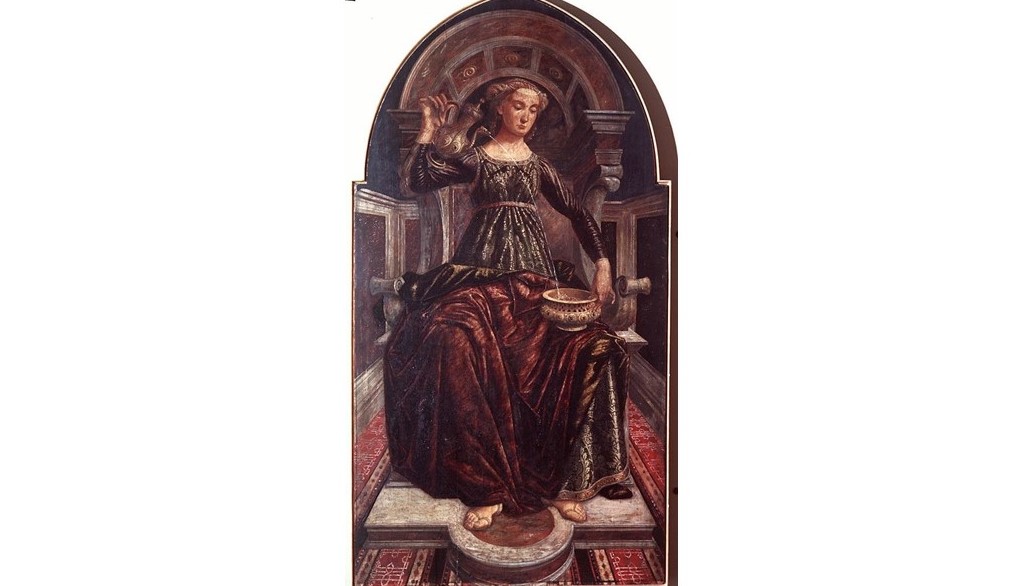+39 0669887260 | info@wucwo.org | Contact us
Art for meditation - July 2024

Piero del Pollaiolo (Florence 1441 - Rome 1496), La Temperanza, 1470, tempera grassa on panel, 168 x 90.5 cm, Florence, Uffizi Museum
The virtues: the Temperance
We would also like to begin this reflection with the words of Pope Francis, who dedicated the audience on Wednesday 17 April to the last of the "cardinal" virtues, the Temperance. And he reminded us that it “is the virtue of the right measure. In every situation, one behaves wisely, because people who act always moved by impulse or exuberance are ultimately unreliable. People without temperance are always unreliable. In a world where many people boast about saying what they think, the temperate person instead prefers to think about what he says. Do you understand the difference? Not saying whatever comes into my mind, like so… no: thinking about what I have to say. He does not make empty promises but makes commitments to the extent that he can fulfil them.”
Piero del Pollaiolo, in the last panel of the cycle dedicated to the virtues we are considering, has also carefully painted Temperance, maintaining the characteristics we have already noticed in the other paintings: a marble throne on which Temperance sits and which rests on a predella or platform that gives prominence and lifts the figure of the young woman, a carpet that covers the entire floor and makes it look so refined.
Temperance, understood as the capacity for moderation and right measure, is depicted by Piero as a young woman in the act of mixing hot water with cold water, pouring it from a jug into a basin. Of this representation we are struck by two things. Firstly, the preciousness of the metal jug and basin: they are in fact both decorated with precious stones, with an accuracy that we know stems from Piero's great familiarity with goldsmithing, which his brother Ambrogio carried out with great success and mastery. The second thing we cannot help but notice is the complexity and vigour with which the folds of both the dress and the cloak are rendered: it is fair to say that they give texture and volume to the woman's body. It almost seems as if our painter wanted to use painting to reproduce another art, namely sculpture, as if to demonstrate the superiority of the former over the latter. During the Renaissance, the debate about the primacy of the arts was very much present, and with this cycle, Piero del Pollaiolo seems to give his answer to the question.
One last remark concerns the support on which Pollaiolo painted all six panels of the cycle he executed (the fortress, let us remember, was instead painted by Botticelli). They are in fact cypress planks, a type of wood that is very resistant to wood-eating insects (and thus potentially the sworn enemy of panel paintings) and humidity. It is clear, then, that the intention was to ensure that the cycle of paintings would last as long as possible, and given the excellent state of preservation in which the panels have come down to us, this has been perfectly achieved.
Temperance is the moral virtue that moderates the attraction of pleasures and provides balance in the use of created goods. It ensures the will's mastery over instincts and keeps desires within the limits of what is honourable. the temperate person directs the sensitive appetites toward what is good and maintains a healthy discretion: "Do not follow your inclination and strength, walking according to the desires of your heart. "Temperance is often praised in the Old Testament: "Do not follow your base desires, but restrain your appetites." In the New Testament it is called "moderation" or "sobriety." We ought "to live sober, upright, and godly lives in this world." (Catechism of the Catholic Church 1809)
Or if one loves justice, the fruits of her works are virtues; For she teaches moderation and prudence, justice and fortitude, and nothing in life is more useful for men than these. (Wisdom 8, 7)
Do you not know that the runners in the stadium all run in the race, but only one wins the prize? Run so as to win. Every athlete exercises discipline in every way. They do it to win a perishable crown, but we an imperishable one.1 (1 Corinthians 9, 24-25)
Be sober and vigilant. Your opponent the devil is prowling around like a roaring lion looking for (someone) to devour. Resist him, steadfast in faith, knowing that your fellow believers throughout the world undergo the same sufferings. (1 Peter 5, 8-9)
For this very reason, make every effort to supplement your faith with virtue, virtue with knowledge, knowledge with self-control, self-control with endurance, endurance with devotion, devotion with mutual affection, mutual affection with love. If these are yours and increase in abundance, they will keep you from being idle or unfruitful in the knowledge of our Lord Jesus Christ. (2 Peter 1, 5-8)
(Contribution by Vito Pongolini)
1. The words translated in English as discipline, sober and self-control in the Italian version form the original text are translated as temperance.